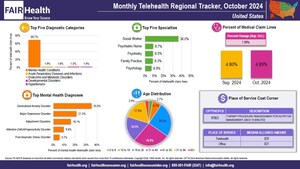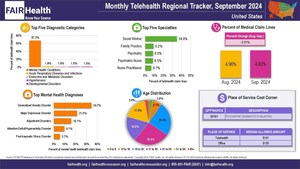After Three Months of Growth, Telehealth Utilization Declined Nationally in February 2023
COVID-19 No Longer Ranked among Top Five Telehealth Diagnoses Nationally or in Any Census Region, according to FAIR Health's Monthly Telehealth Regional Tracker
NEW YORK, May 3, 2023 /PRNewswire/ -- National telehealth utilization declined 6.8 percent in February 2023, from 5.9 percent of medical claim lines in January to 5.5 percent in February, according to FAIR Health's Monthly Telehealth Regional Tracker.1 The decline followed three months of growth from November 2022 to January 2023. In February, telehealth utilization also decreased in all four US census regions—the Midwest (8.7 percent), the South (8.3 percent), the West (6.2 percent) and the Northeast (1.5 percent). The data represent the privately insured population, including Medicare Advantage and excluding Medicare Fee-for-Service and Medicaid.
Top Five Telehealth Diagnoses
In February 2023, COVID-19 no longer ranked among the top five telehealth diagnoses nationally or in any region. The previous month, it had ranked in third place nationally and in the Northeast and in fourth place in the South.
In February, mental health conditions, the top-ranking diagnosis nationally and in every region, rose from 65.9 percent of telehealth claim lines nationally in January to 66.7 percent in February. Also in February, sleep disorders entered the rankings in the Midwest, replacing encounter for examination in fifth place.
Asynchronous Telehealth
In February 2023, hypertension was the most common diagnosis via asynchronous telehealth in the Northeast and the Midwest, rising from second place.2 Hypertension continued to rank second nationally and in the West and fourth in the South, as it had in January.
In February, mental health conditions fell from third to fourth place nationally among the top five diagnoses via asynchronous telehealth.
Audio-Only Telehealth Usage
In February 2023, utilization of audio-only telehealth services decreased nationally and in the Northeast and South. It increased in the Midwest and in rural areas of the West, but stayed level in urban areas of the West. Utilization of audio-only telehealth services was generally higher in February in rural areas than urban areas, except for in the South, where audio-only telehealth services accounted for 10.1 percent of telehealth claim lines in urban areas compared to 5.5 percent in rural areas.
Telehealth Cost Corner
For February 2023, the Telehealth Cost Corner spotlighted the cost of CPT®3 97802, therapy procedure for nutrition management, each 15 minutes. Nationally, the median charge amount for this service when rendered via telehealth was $50.48, and the median allowed amount was $32.36.4
About the Monthly Telehealth Regional Tracker
Launched in May 2020 as a free service, the Monthly Telehealth Regional Tracker uses FAIR Health data to track how telehealth is evolving from month to month. An interactive map of the four US census regions allows the user to view an infographic on telehealth in a specific month in the nation as a whole or in individual regions. Each infographic shows month-to-month changes in volume of telehealth claim lines and audio-only telehealth usage (urban versus rural); the Telehealth Cost Corner, which presents a specific telehealth procedure code with its median charge amount and median allowed amount; and that month's top five telehealth diagnoses and top five diagnoses via asynchronous telehealth.
FAIR Health President Robin Gelburd stated: "We welcome sharing these varying windows into telehealth utilization as it continues to evolve. This is one of the many ways we pursue our healthcare transparency mission."
For the Monthly Telehealth Regional Tracker, click here.
Follow us on Twitter @FAIRHealth
About FAIR Health
FAIR Health is a national, independent nonprofit organization that qualifies as a public charity under section 501(c)(3) of the federal tax code. It is dedicated to bringing transparency to healthcare costs and health insurance information through data products, consumer resources and health systems research support. FAIR Health possesses the nation's largest collection of private healthcare claims data, which includes over 41 billion claim records and is growing at a rate of over 2 billion claim records a year. FAIR Health licenses its privately billed data and data products—including benchmark modules, data visualizations, custom analytics and market indices—to commercial insurers and self-insurers, employers, providers, hospitals and healthcare systems, government agencies, researchers and others. Certified by the Centers for Medicare & Medicaid Services (CMS) as a national Qualified Entity, FAIR Health also receives data representing the experience of all individuals enrolled in traditional Medicare Parts A, B and D; FAIR Health includes among the private claims data in its database, data on Medicare Advantage enrollees. FAIR Health can produce insightful analytic reports and data products based on combined Medicare and commercial claims data for government, providers, payors and other authorized users. FAIR Health's systems for processing and storing protected health information have earned HITRUST CSF certification and achieved AICPA SOC 2 Type 2 compliance by meeting the rigorous data security requirements of these standards. As a testament to the reliability and objectivity of FAIR Health data, the data have been incorporated in statutes and regulations around the country and designated as the official, neutral data source for a variety of state health programs, including workers' compensation and personal injury protection (PIP) programs. FAIR Health data serve as an official reference point in support of certain state balance billing laws that protect consumers against bills for surprise out-of-network and emergency services. FAIR Health also uses its database to power a free consumer website available in English and Spanish, which enables consumers to estimate and plan for their healthcare expenditures and offers a rich educational platform on health insurance. An English/Spanish mobile app offers the same educational platform in a concise format and links to the cost estimation tools. The website has been honored by the White House Summit on Smart Disclosure, the Agency for Healthcare Research and Quality (AHRQ), URAC, the eHealthcare Leadership Awards, appPicker, Employee Benefit News and Kiplinger's Personal Finance. FAIR Health also is named a top resource for patients in Dr. Elisabeth Rosenthal's book An American Sickness: How Healthcare Became Big Business and How You Can Take It Back. For more information on FAIR Health, visit fairhealth.org.
Contact:
Rachel Kent
Senior Director of Communications and Marketing
FAIR Health
646-396-0795
[email protected]
1 A claim line is an individual service or procedure listed on an insurance claim.
2 Asynchronous telehealth is telehealth in which data are stored and forwarded (e.g., blood pressure or other cardiac-related readings transmitted electronically; A1c levels transmitted electronically).
3 CPT © 2022 American Medical Association (AMA). All rights reserved.
4 A charge amount is the provider's undiscounted fee, which a patient may have to pay when the patient is uninsured, or when the patient chooses to go to a provider who does not belong to the patient's plan's network. An allowed amount is the total fee paid to the provider under an insurance plan. It includes the amount that the health plan pays and the part the patient pays under the plan's in-network cost-sharing provisions (e.g., copay or coinsurance if the patient has met the deductible).
SOURCE FAIR Health

WANT YOUR COMPANY'S NEWS FEATURED ON PRNEWSWIRE.COM?
Newsrooms &
Influencers
Digital Media
Outlets
Journalists
Opted In






Share this article